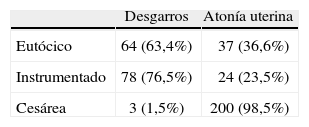Analizar la experiencia de la embolización arterial en el manejo de la hemorragia masiva en la paciente obstétrica.
Pacientes y métodosEstudio retrospectivo y observacional en el que se analizaron todos los partos, que requirieron transfusión sanguínea, realizados en la maternidad del Hospital Universitario La Paz durante el periodo comprendido entre el 1 enero del 2000 y el 31 de diciembre del 2005.
ResultadosSe realizaron 57.835 partos, siendo la incidencia de hemorragia obstétrica del 0,7% (406 episodios). A 51 pacientes se les realizó una embolización arterial y a 45 se les practicó una histerectomía obstétrica. En 11 pacientes se realizaron ambos procedimientos. Diez de las pacientes a las que se les realizó una histerectomía obstétrica precisaron posteriormente una embolización arterial, mientras que sólo una paciente embolizada precisó en último término una histerectomía obstétrica por no resolverse el cuadro hemorrágico. La media de consumo de hemoderivados fue del doble en la histerectomía obstétrica respecto a las pacientes embolizadas. No se evidenciaron complicaciones secundarias a la embolización arterial.
ConclusionesLa embolización arterial es un procedimiento seguro y eficaz para el manejo de la hemorragia masiva obstétrica.
To analyze our experience with uterine artery embolization in the management of massive hemorrhage in obstetric patients.
Patients and methodsThis observational, retrospective study analyzed all deliveries requiring a blood transfusion that were performed in the maternity unit of Hospital Universitario La Paz between January 1, 2000 and December 31, 2005.
ResultsAtotal of 57 835 deliveries were performed with an incidence of postpartum hemorrhage of 0.7% (406 episodes). Uterine artery embolization was performed on 51 patients and 45 patients underwent obstetric hysterectomy. Both procedures were performed on 11 patients. Ten of the patients who underwent obstetric hysterectomy subsequently required uterine artery embolization, whereas only 1 patient required an obstetric hysterectomy following embolization because the hemorrhage was not resolved. The mean consumption of blood products for patients who underwent obstetric hysterectomy was twice that for patients who underwent uterine artery embolization. There were no complications secondary to embolization.
ConclusionsUterine artery embolization is a safe and effective procedure for managing massive postpartum hemorrhage.
Artículo
Comprando el artículo el PDF del mismo podrá ser descargado
Precio 19,34 €
Comprar ahora











